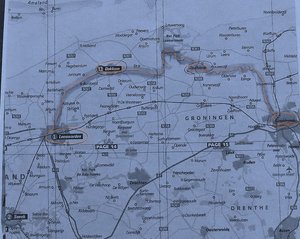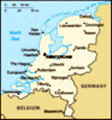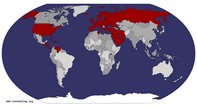Advertisement
Published: January 26th 2016

 Our Travels from Groningen to Leewarden
Our Travels from Groningen to Leewarden
via Zoutcamp & Dokkum definitely was not a straight line run, but a very enjoyable one!Even though a road trip from Groningen to Leeuwarden would take about 45 minutes it is a much slower and longer trip via canal (and I am pretty confident in saying a more pleasant trip!) The canal that we had to take took us northwest to Zoutcamp, then we continued on to the Lauwersmeer (large lake with access to the sea) where we started turning southwest. This led us to an overnight stop in Dokkum. This portion of the canal again took us through plenty of farm land as well as through fishing areas which we have to always watch for no matter where we travel. We saw many more commercial fishing boats when on the Lauwersmeer with its direct access to the sea. As there is quite a distance between towns in this stretch of the canal system they have provided numerous places that you can tie up your boat for the night if you wish to. Some of these had a dock where you at least had access to some land that you could get off your boat for the night – other areas due to the depth of the water, the tie ups were just tie ups with
no land around – they put in a place to stop safely for the night and that is all. Still a nice addition to the canal system. We didn’t take advantage of any of these as we decided to push on to Dokkum so we could have an evening walking around the town.
We found out that Dokkum was a well preserved fortified town with its 5 star design still very visible. They historically had 5 mills in town, but only 2 are still remaining and are an excellent landmark for the town. If you look at a map you may wonder why this town was fortified as it is currently a distance from the sea. Believe it or not it had become a port town in the 13
th century but this all changed with the building of locks in 1729 separating it from the sea. As we got into town after places were closed it didn’t take us long to wander around and take a few photos of some of the buildings and of course the windmills. One thing that we really appreciate is that the towns along the canal have wonderful tie ups for your boat if
you wish to stay over. Where we were located there weren’t any facilities, but as Tsamaya is self-contained, that wasn’t a problem at all for us.
The next morning we pushed off as we wanted to make it to Leeuwarden. As with other towns we found that there were plenty of places to tie up Tsamaya. We found a place close to the shower/bathroom facilities, electricity and water – what a deal for the equivalent of about $12.50 US per night. The fee you paid through an automated machine similar to an ATM - very convenient indeed. Like a car parking lot the machine gives you a tag showing that you paid which you put on the safety line of your boat to show that you paid. A very efficient and easy system.
As always when coming into a new town we take a wander around as soon as we can and find the tourist information center. We found out that Leeuwarden is the capital city of the province of Friesland. The Fries Museum (pronounced frees) was highly recommended so the next day we checked it out. The museum has been in existence since 1881 with the main
goal of preserving the history of Frisian culture. We enjoyed our day at the museum, the only down side we saw was that they did not have any labels in English. They did provide a written handout in English that was not very clear in its direction as to where the particular items were that they were describing. We did feel that we missed out on some of the history that was provided, but still with that shortcoming we would recommend taking the time to visit as the exhibits themselves in many cases were self-explanatory.
One area of the museum was dedicated to items related to WWII as many may not be aware that the Netherlands was under Nazi occupation starting in 1940 and therefore was quite affected by a large loss of their Jewish population. One of the famous resident’s of Leeuwarden was the dancer spy, Mata Hari so the museum has an exhibit dedicated to her as well.
The other parts of the museum covered the history of the area and the people that live here. Many exhibits were well done, but unfortunately we probably missed out on some of the details due to the lack
of a detailed English guide. Our suggestion to the museum here would be to create an audio guide that people could use when touring. It was somewhat surprising that they didn’t have anything like this as the majority of museums these days have these available.
Another museum we decided to take in was the Princessehof National Museum of Ceramics. We weren’t sure what to expect and thought it would not take too much time to go through but instead found it quite fascinating and very informative. As you first go in you are able to see one of the rooms as it would have been as the royal residence for Princess Von Hessen Kassel. The rest of the time you are taught the importance of the ceramic trade to the Dutch East India Company as well as learn how the Chinese adapted their products for western taste. The differences between Japanese and Chinese ceramic techniques and design are also highlighted in the exhibit. This museum did an excellent job of having signage in both Dutch and English so we were able to follow the history of ceramics from ancient times to the present. With all of the discussion of

 Some Canals We Can Not Enter
Some Canals We Can Not Enter
due to the height of the bridges which do not opentea and the collection of teapots they had, a stop at their tea café was a must at the end of our exploration. Definitely an enjoyable and educational day. On the outside of the building there was a design done by MC Escher. He was another famous resident of Leeuwarden having been born here and lived the first 5 years of his life in this same home.
With an extensive canal system that runs through the town we decided to get some use out of our dinghy so took it for a “spin”. It was great to be able to explore the smaller canals that we cannot enter with Tsamaya. We had thought of doing this in other places, but this is the first time we actually did some exploration. It was nice as it got us to parts of the city that we hadn’t walked to yet.
Franeker is a town that is about 12 miles west of Leeuwarden. Friends of ours that had cruised through here previously told us that there was a very interesting planetarium located there. We found that we could easily take public transportation there so we had another day trip planned. To
say the planetarium was interesting was an understatement. It was actually built between the years of 1774 and 1781 by a wool carder and amateur astronomer named Eise Eisinga in his home. As stated on the planetarium website he was prompted by ” a conjunction of planets that occurred on 8 May 1774. Before it happened, people insisted that these planets would collide with one another, the result being that the earth would be pulled from its orbit and incinerated in the sun. Eise Eisinga wanted to show that there was no reason for panic.”. The building of this was quite an accomplishment in itself as it was built completely to scale, but the most amazing part is that it is still accurate to this day. The planets in his model move at the same speed that they do in reality – ie. The Earth takes 1 full year to orbit around the sun, Mercury takes 88 years and so on. The mechanism for all of this is located above the ceiling and works by the use a wooden gear system which he made from wooden hoops and 10,000 hand forged nails that create the teeth of the gears. He

 St Boniface Church in Dokkum
St Boniface Church in Dokkum
a Neo-Gothic style church built 1871-1878not only did a model to scale of the heavens, but he also created dials that show numerous types of information. These include the phases of the moon, the time of sunrise, sunset, moon rise and set. The accuracy of the mechanism that he created really hits you when you see that it even shows the exact day that you are there with the day of the week and the month, date and year! The only thing that the staff at the Planetarium have to do to make this possible is “a slight "re-setting" by hand every four years to compensate for the February 29th of a
leap year. The plank that has the year numbers written on it has to be replaced every 22 years.
The location of all of this is in the living space of his house, in the photos you can see that the sleeping area is located at the far end of this room. Also in that area is the weights that are from a pendulum clock which drive the mechanism located above the ceiling. The whole solar system was built to scale (1:1,000,000,000,000 / 1 millimetre: 1 million kilometres) which allows it to be
so accurate even to this day! A visit to the Eise Eisinga Planetarium, the oldest planetarium in the world is a must if you are even close to Franeker. We feel fortunate to have had the chance to visit.
While in Franeker we also took a tour through the Town Hall. The main portion of the building was started in 1591 and the west wing was added in 1760. They provided a very interesting tour of the rooms which also had excellent English write-ups about the history and furnishings. One of the rooms, The Wedding Room is still used for that same function as of today. It has gold leather on its walls which at one time was common to use, but when wallpaper became popular it replaced the leather. Luckily here the gold leather was in excellent condition so has remained on the walls. We also learned that symmetry was an important design feature used in many buildings. It was clearly shown here with the installation of a doorway that was fake with a brick wall behind it so that it would have a symmetrical look in the room. The things you learn on these tours!
Janice
has been having some problems with her arms and legs so figured that if we stayed in one place longer she might get a little better. At first it seemed to be just the muscles in her legs after our long bicycle ride that we had taken when we were in Delfzijl, but unfortunately it seems to be getting worse in that it has affected her arms as well. Since leaving Delfzijl Janice has been able to do less and less on the boat so it has meant that Bob has been single handing more and more which doesn’t make it easy when coming into a dock or tying up waiting for a bridge to open. We figured it was time to try to find a Dr. to see if they could figure out what was happening. Now was the fun part of trying to find someone to go to. With a socialized medical system physician offices are not set up for people making a payment for services. When calling around to various offices the problem was either that we were not a resident of a particular area that they provided services to or if you got over that hurdle
they couldn’t accept payment. After calling quite a few offices we finally found one that we could set up an appointment with. With the way her legs have been walking is much slower so it took us some time to get to the office, but we made it. Found it was on the 2
nd floor and Janice is to the point that she even had to use the elevator as the stairs was too difficult to manage. Not good at all. Surprisingly when called in from the waiting room, it was actually the Dr. himself that came out to get Janice. Much different from the US. After taking the medical history and hearing what has been happening he decided to take some blood work. The Dr. himself actually walked with Janice down to the lab and waited while the blood was being drawn. He was trying to rule out a few things and hoped that the test would do this. Nothing to do now but wait for the results. Found out that the Dr. ruled out the worse things that he was checking on, but he didn’t have any definite answers for us. As Janice had some symptoms earlier of
an viral infection the Dr. thought it could have had an impact on her muscles. His suggestion was to take it easy a little while longer and if it doesn’t clear up to check in with a Dr. when we get to Amsterdam. When I left the office they didn’t provide a bill so they said they would figure out something for me to be able to pay. No real answers on what is causing the problem with Janice’s legs and arms.
As we had been in Leeuwarden for some time now our boat seems to have drawn a little bit of attention. It is not that common to see a US flagged vessel traveling through the canals here. As people walk by where we are stopped we get a chance to visit with some of the people here. Fortunately for us one in particular kept stopping by with her two children. We looked forward to our visits from Ellen, Isabella and Quinten. They would come by quite often and we would visit with the kids asking questions at times. We had them on the boat and they seemed to have fun checking it out. Bob of course got

 One of the Windmills in Dokkum
One of the Windmills in Dokkum
located on one of the 5 points of the fort designinto his teaching mode and showed them around. They found out what day we had decided to leave and stopped by with a few gifts – some very excellent cookies and traditional treats (caramel wafers called stroopwafel that are excellent when you set them over your hot coffee which softens them just a little – a trick we learned from our Dutch friends!) Isabella and Quinten made us an animal made from a chestnut that they had collected. We of course put it in a very visible spot on the boat and it is still there as of today! It is meeting people like these that make wonderful memories of our travels. When we take the time to stop in a town for longer than a day or two we have more of a chance of having these great encounters.
We also had a visit from a reporter and photographer working at the local newspaper. They came onboard and interviewed us about our travels. After leaving Leeuwarden, we were tied up near a bridge waiting for it to open when we heard someone standing on the bank shout at us “your under arrest, your under arrest” – needless to

 A Few of the Homes in Dokkum
A Few of the Homes in Dokkum
Many are very impressive such as thesesay that got our attention. Come to find out the gentleman wanted to give us a newspaper which we saw had the article and photo of us. He said he was sitting there by the canal reading the paper when he looked up and saw “Tsamaya” go by and he wanted us to catch us – that is why he shouted what he did– what are the odds of that!! Quite the funny encounter indeed.
We definitely enjoyed our 2 weeks in Leeuwarden, but we need to keep moving. Next on the agenda is stopping in the village of Grou and on to Sneek which I’ll let you know about in the next blog entry.
Advertisement
Tot: 0.126s; Tpl: 0.02s; cc: 15; qc: 28; dbt: 0.0645s; 1; m:domysql w:travelblog (10.17.0.13); sld: 1;
; mem: 1.2mb

















































